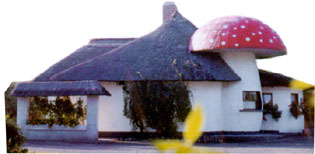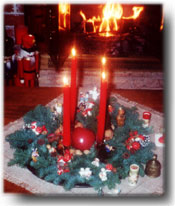
An oral history and intergenerational dialogue
by Ursula and Mark Hoffman
appeared in Entheos, No. 1, Summer 2001;
MH: Hey, mom! Thanks for taking the time to answer some questions about one of my favorite subjects. Why don’t we start by letting you tell us what comes to mind when you think of the Fliegenpilz.
UH: Der Fliegenpilz (fly-mushroom) - or Glückspilz (happiness-mushroom) - that pretty little white mushroom with the stunning, bright red hat full of little white dots. I remember my parents telling me not to touch the mushroom because it looks much prettier sitting in the woods, particularly when a sunbeam shines through the canopy of leaves and lights up its red cap and its snow white stem. Besides, you can’t eat it anyway because it is full of terrible poison. Perhaps that is why it is called “Fliegenpilz;” flies are probably drawn to it by its fragrance to feed on it and die? I want to believe that its second name, “Glückspilz,” may have come from the happiness you feel when you stumble across a collection of them or just a single, perfectly shaped one, in the forest. It makes you happy to see them, and you feel lucky to have found some. You have told me that reference to the Fliegenpilz is found in the history of many religions for as long as such history has been recorded. I didn’t know this when I was growing up; it was never mentioned to me by anyone. We used a likeness of the Fliegenpilz in Germany to decorate for Advent and Christmas. There were glass tree ornaments, little wooden candleholders shaped like Fliegenpilze (plural) and small pressed-cotton mushrooms with a lacquered red cap and white dots in all kinds of sizes, tied together with red berries and tiny pine cones... pretty little decorations. There was even a restaurant shaped and painted like a giant Fliegenpilz somewhere alongside a road in the heather country, near Osnabrück. It used to be a favorite place for a break on the more than an hour-long drive from Wolfsburg to Lüneburger Heide, particularly when the heather was blooming. I have fond memories of those times. The place was called the “Milchbar” (Milk Bar); it was a cafe where you could get coffee and cake, but it also served ice cream, yogurt, hot rice-milk, and other dishes of that sort. Locals called the restaurant “Der Fliegenpilz”. I have a picture of it somewhere.

"The Milk Bar" on Route B-4, in Niedersachsen,
(northern) Germany. Mid 1960's
photo by Urusula Hoffman
MH: We’re going to have to find that! It’s interesting you mention the mushroom as a fly killer - this is the generally accepted explanation for its popular name “fly-mushroom”. Wasson seriously questioned this, citing his own experiments, and those of a correspondent, who both failed to kill any flies. Wasson presents a compelling argument that the fly connection has to do with the association of the mushroom with ‘flying insects’ - generically grouped together as ‘flies’ in the old European languages. These insects, including what we call today flies, were thought to carry souls and familiar spirits, and sometimes brought possession or madness to those they infect. This “madness” or “possession” is the practical connection to this psychoactive mushroom. From my own unintentional experiments, I have concluded that common flies are killed by this mushroom. Once this occurred on top of my VW camper, where mushrooms were placed to dry. I found at least a half dozen flies dead next to the mushrooms, both in and around the rain water that had collected in the plastic roof rack. On another occasion I was finding several dead flies every day on a window sill, where muscarias were drying. It seems that the Fliegenpilz is capable of killing, not just stunning, flies. The fly connection probably ‘stuck’ for both reasons, as well as the fact that flies love to lay eggs in these mushrooms, as they do others. This brings us to another common name that I wanted to ask you about. Have you heard the word “Narrenschwamm”? It’s a word that Wasson associated with the name “fool’s mushroom”, which was common in other parts of Europe.
UH: I do vaguely remember the word “Schwamm” in connection with mushrooms. “Narren” are jokers, silly fun-makers, court jesters, that’s what I think they called them in the old days; “Schwamm” is a sponge. That’s about all I can tell you.
MH: A “sponge” designation makes sense since mushrooms hold a lot of water. The “Narren” connection also makes sense when you consider the effects of the mushroom. Such effects are probably the only good explanation of the second most common German name for the fly-agaric - Glückspilz (happiness-mushroom). This hardly seems an appropriate name for an infamously “poisonous” mushroom. Let’s talk a bit more about Christmas decorations. What else can you tell us?
UH: Well, everyone decorates a little differently. We did not always use the plate for the Advent candles; we sometimes made a wreath with red, silver, or gold ribbons wrapped around it and four red candles sitting on it. The ribbons would then be extended to hang the wreath from a table stand, a bright red lacquered, wooded stand. Some people would hang the wreath from the ceiling, and in stores they would have very large ones that would hang from the ceiling. In between the candles there would often be decorations like pine cones, Fliegenpilze, and so on. In addition to the wreath, we always had a Christmas plate full of sweets, nuts, apples and pine greens. This is where, I think, the “Adventsteller” (see photos) came from. We gradually got away from the wreath, putting our candles on the plate, but we still continued to set up a place for sweets, in addition to the advent plate.
MH: Please describe what you put on the plate? Did most people have advent plates?
UH: Everyone we knew had one. They always had four candles, (red if possible), pine greens of different kinds, small pine cones, Fliegenpilze, little wooden figurines, and, in the middle, a shiny red apple. A collection of various nuts was also very common. One month before Christmas, usually on a Sunday, we would burn one of the candles for an hour or two. The following week we would do the same, adding an additional candle, and so on. This all led up to Christmas Eve, when all four candles would finally be lit.


MH: Scandinavians also have a Yule tradition that features a bright red apple among red candles and pine branches. It seems to me that this motif, originally at least, was related to the mushroom. In Germany and elsewhere, the mushrooms themselves survived as decorations.
UH: The Fliegenpilze were, as long as I can remember, always part of the decorations in our house. As I mentioned earlier, often people would add personal touches, and this is true for the Advent plate; not everyone uses the same decorations, and some still use wreaths.
MH: I understand that Fliegenpilze ornaments are common in other European countries like Austria, Switzerland, Sweden, and Norway. What do you know about the symbolism of the advent plate and its pine needles and cones, the apple, etc.?
UH: Nothing. I added little angel-musicians because they were cute. Growing up, I never questioned the presence of Fliegenpilze or any other Christmas decorations.
MH: Tell us more about your parents. Did they like to eat mushrooms?
UH: They were both born in Osnabrück in the state of Westfalen (Westfalia), in northern Germany. Oma (your grandma) would not eat them. Only Opa (your Grandpa) and I did that; we both liked them. I don’t remember if my sister, Doris likes mushrooms, but I think she does now. Opa used to bring them home by the bag full, and then Oma had to clean and cook them. She didn’t like that very much.
MH: Did you forage more during the war?
UH: Yes, of course, because food was scarce. We collected mushrooms (mostly Opa, because he was the only one who knew what to look for without poisoning us all), berries, and Bucheckern (little nuts with very high oil content).
MH: Were you told stories about fairies, gnomes, etc.? Did you know the story of Little Red Riding Hood?
UH: “Rotkäppchen,” translates “little red cap,” as in “hat”! This has nothing to do with riding! Yes, we were told those stories.
MH: I can’t remember where I saw it, but I know there is a European story about witches that are specifically distinguished by their wide-brimmed red hats. In Bauer’s Fliegenpilz book, the red hat/muscaria connection is extended from the ancient mystery god Mithra to modern garden gnomes - all of whom, almost invariably, wear red caps. You know, the fly-agaric has been an important element in fairy tales and folk traditions. If you think about it, what is the connection between a colorful mushroom - especially an allegedly “poisonous” one - and Christmas? Santa also wears a red cap... When one considers certain Christmas traditions having to do with Santa Claus and pine trees, we can start to understand the sources behind something as seemingly benign as Christmas mushroom decorations. We have a very shamanic St. Nick magically navigating up and down chimneys, as a shaman would a the ‘world tree’; he leaves brightly-colored gifts beneath pine trees - where one would look for Fliegenpilze, growing as they do, in relationship with these trees. It is also interesting that stockings are hung, as would a string of mushrooms to dry, in front of the fireplace. There are other parallels that have been mentioned by writers. Before Christianity, Wotan’s flying white horse seeded the fly-agaric with the foam falling from its mouth; this also happened during the Winter Solstice. It isn’t far to go between Wotan and St. Nick... And all of this is only scratching the surface! Did you know that in Germany it was believed that it “rained” mushrooms on St. Peter’s and St. Paul’s Days? St. Anthony is also connected with mushrooms. It is said he walks through the forest with his magical staff, calling the “good” mushrooms from their hiding places. The fact that the most beloved, and most taboo mushroom happens to be a potent, if fickle, psychedelic seems to betray it’s ancient magical and sacred role. What do you think of all this?
UH: Sounds good to me, but then you’ve told me things like this before.
MH: You’re supposed to tell me I’m crazy.
UH: O.K., you’re crazy!
MH: I assume the Fliegenpilz grows in your home town (Wolfsburg)? We have found wonderful evidence of the fly-agaric in the Christian art of Hildesheim, only an hour from there.
UH: Yes, it grows in forested areas around Wolfsburg. I’ve seen it elsewhere also; I’m sure it grows all over the forests of northern Germany.
MH: You mentioned chimney sweeps at one point. Please explain their connection, as far as you know, with the Fliegenpilz?
UH: This is a New Years tradition. Chimney sweeps are considered lucky and they carry both the Glückspilz and four leaf clover to bring good luck in the coming year.
MH: You also had mentioned an interesting recipe for “Fligenpilze Eier” (fly-mushroom eggs). Would you please repeat it?
UH: Sure. A hard-boiled egg makes the stem, cut flush on one end so it won’t tip over. Cut a small tomato in half and hollow it out. Put mayo on top of the egg for stability, and set the tomato half on top, then add ‘spots’ of mayo. It looks particularly good sitting on some nice green lettuce.
MH: Watch out Martha Stewart! You’ve never made these for us: we’ll have to make some next Christmas! Or would you rather try the real thing?
UH: OH NO, NOT THE REAL THING! And I wish you wouldn’t either! You have to be crazy to eat those!
MH: Next subject: have you heard the following nursery rhyme?
Ganz still und stumm
Er hat von lauter Purpur
Ein Mäntelein um.
Sag’ ver mag das Männlein sein
Das da steht auf einem Bein?
Glückspilz!
Fliegenpilz!
very still and mute.
He has of deep red
a little coat around him.
Say, who may the little man be
that stands there on one leg?
Happiness-mushroom!
Fly-agaric!

UH: OHHH! Where did you find this?!? I had completely forgotten
about this little song! (She sings it.)
MH: Wasson mentions it. It’s great that you also remember
the melody! You realize that we’ll have to post your singing on the web! (Audio
to be posted here soon! )
Thanks mom!


This is will be an ongoing site dedicated to our beloved Fliegenpilz. We would love to hear any and all traditions on the subject!
